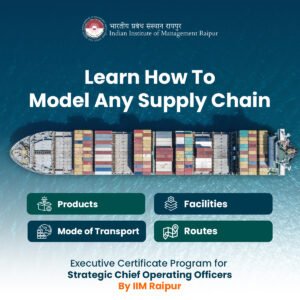In the intricate world of supply chains, where products embark on epic journeys from factory floors to your doorstep, there exists a silent hero, often overlooked and underestimated.
Imagine, for a moment, a bustling kitchen. The chef, orchestrating a symphony of ingredients, knows that having just the right amount of spices, veggies, and secret sauces at the perfect time can mean the difference between a culinary masterpiece and a culinary disaster.
Now, let's zoom out from that kitchen and take a macroscopic look at the intricate world of businesses and their supply chains. The unsung hero in this grand production is none other than Inventory Management!
So, if you've ever wondered how the latest gadget or that cozy sweater magically appears at your doorstep right when you need it, join us on a captivating journey into the heart of supply chain efficiency. Discover the secrets, strategies, and sheer magic behind inventory management that keeps the world's commerce wheels turning smoothly.
Overview of Inventory Management
Imagine you run a lemonade stand. You have lemons, sugar, cups, and all the stuff you need to make lemonade. Now, Inventory Management is like making sure you have the right amount of each of these things.
You don't want too many lemons sitting around getting old and mushy, right? That's a waste of money and space. But you also want to stay put in lemons when a big crowd shows up at your stand. That would be a lemonade emergency!
So, Inventory Management is all about finding that sweet spot – having just the right amount of lemons, sugar, cups, and everything else. It's like a balancing act. You keep track of what you have, what you need, and when you need it.
Mastering the Art of Inventory Management: Crafting an Efficient Storage Ecosystem
In the intricate dance of supply chain logistics, the way we handle inventory isn't just a small detail—it's the secret ingredient to the smooth operation of product storage. Picture it as the conductor's wand, gracefully directing a symphony of efficiency.
As we refine our techniques and embrace innovative management principles, the entire orchestra of logistics comes to life. This evolution enhances not just the movement of goods but also the tempo of delivery, the melody of service quality, the harmony of operational costs, the choreography of facility usage, and the energy-saving encore.
Think of inventory optimization in logistics as the virtuoso soloist in this grand performance. Its role is pivotal, akin to the artist who manipulates the logistics canvas, weaving together the intricate threads of supply chains into a masterpiece. From storage to delivery, every note it plays shapes the grand composition, ensuring that logistics sings in perfect harmony.
What are the key components of inventory management in supply chains?
When we talk about inventory, we're really talking about the different parts that make up your stock, like the building blocks of a Lego set. Knowing these components is key to managing your inventory efficiently.
- Raw Materials and Supplies: These are the basic ingredients or elements you need to create your products. For example, if you're running a bakery, flour, sugar, and eggs are your raw materials.
- Work-in-Progress Inventory: Imagine you're in the middle of baking a cake. The cake batter, partly assembled, is your work-in-progress inventory. In a larger manufacturing setting, it could be partially assembled car parts or half-sewn fabric in a clothing factory.
- Finished Goods Inventory: These are the fully assembled, ready-to-sell products. If you're a smartphone manufacturer, the phones that are boxed up and ready for stores are your finished goods inventory.
Inventory control in optimizing supply chains involves understanding these components and finding the right balance. So, keep these aspects in mind as you aim to maintain a well-oiled supply chain.
Remember, whether you're a small lemonade stand or a giant tech company, knowing what's in your inventory is crucial. It's like having a well-organized toolbox where you can quickly find the right tool for the job, making your business more efficient and cost-effective.

Significance of Inventory Management
- Cost Efficiency
Efficient inventory management reduces costs by preventing overstocking or understocking, minimizing storage expenses, and curbing the risk of spoilage or obsolescence.
- Customer Satisfaction
When you have the right products in the right quantities at the right time, customer orders are fulfilled promptly, leading to increased customer satisfaction and loyalty.
- Working Capital Management
Optimized inventory levels free up capital that can be used for other vital aspects of your business, such as expansion or innovation.
- Risk Mitigation
Inventory management helps mitigate risks associated with fluctuations in demand, supply chain disruptions, or economic downturns. It enables you to adapt to market changes quickly.
- Data-Driven Decision Making
Modern inventory management relies on data analysis and forecasting, allowing businesses to make informed decisions about inventory levels, ordering, and pricing.
How does efficient inventory management improve the supply chain?
In the business world, this balancing act is even more important. Companies have lots of things they need to make or sell, like gadgets or clothes. They use Inventory Management in a supply chain to make sure they only have a little stuff sitting around, costing them money. But at the same time, they make sure they always have enough to meet customer demands.
Think of it as the secret sauce that keeps businesses running smoothly. If they get it right, they save money and keep their customers happy. If they get it right, they can retain money and customers.
Inventory Management is like being the Lemonade Stand Boss, making sure you never run out of lemons but also never have too many. It's all about finding that perfect balance in the stuff you have, just like the perfect balance in a glass of refreshing lemonade.
Effective Inventory Management Techniques
ABC Analysis
- What is ABC Analysis?
ABC analysis categorizes inventory items into three classes based on their importance and value: A (high-value items), B (medium-value items), and C (low-value items).
- How does it work?
By prioritizing high-value items (A) for rigorous control and low-value items (C) for minimal control, companies can focus their resources on what matters most.
- Benefits
This technique optimizes inventory investment, reduces holding costs, and enhances overall inventory efficiency.
Just-In-Time (JIT) Inventory Management
- What is JIT?
JIT is a system that aims to have inventory arrive precisely when it's needed, eliminating the need for excessive stockpiles.
- How it Works:
By reducing excess inventory, JIT reduces holding costs and the risk of obsolescence.
- Benefits:
JIT minimizes waste, increases efficiency, and allows companies to adapt quickly to changing market conditions.
Economic Order Quantity (EOQ)
- What is EOQ?
EOQ calculates the optimal order quantity to minimize total inventory costs, including ordering and holding costs.
- How it Works:
By determining the ideal order quantity, companies can reduce holding costs without running the risk of stockouts.
- Benefits:
EOQ helps companies find the right balance between overstocking and understocking.
Demand Forecasting
- What is Demand Forecasting?
Demand forecasting uses historical data and market trends to predict future demand for products.
- How it Works:
Accurate demand forecasting ensures that companies have the right inventory on hand to meet customer demands.
- Benefits:
Demand forecasting reduces the risk of stockouts and overstocking, improves customer service, and streamlines supply chain operations.
The Domino Effect of Inventory Management on Supply Chains
Imagine a supply chain as a row of dominoes waiting to fall into perfect harmony. Each domino represents a step in the journey of a product, from its creation to your doorstep. Now, picture inventory management as the careful hand that ensures these dominos fall precisely, one by one, without any chaos.
When inventory management is on point, the entire supply chain hums like a well-rehearsed orchestra. But when it falters, the harmony turns into cacophony.
Here's why it's so crucial:
- Balancing Act: Inventory management is the tightrope walker of supply chains, balancing between excess and shortage. Too much inventory ties up money and space, while too little can leave customers waiting and frustrated.
- Cost Implications: A misstep in inventory management can cost a business dearly. Overstocking results in extra storage and maintenance expenses, while understocking leads to lost sales and potential customer trust issues.
- Customer Satisfaction: The ultimate goal of any supply chain is to deliver products into the hands of eager customers. Effective inventory management ensures products are available when needed, making customers happy and loyal.
In essence, inventory management is the conductor orchestrating the supply chain efficiency strategies. When done right, it's a masterpiece of efficiency. When it goes awry, it's a discordant mess. It's the difference between a smooth, on-time delivery and a frustrating delay.
The Final Words
Inventory management is a vital component of efficient supply chain operations. It impacts cost efficiency, customer satisfaction, working capital, and risk mitigation. By implementing effective inventory management techniques like ABC analysis, JIT, EOQ, and demand forecasting, businesses can optimize their inventory, reduce costs, and maintain a competitive edge in today's dynamic marketplace.
Optimizing your inventory management is an ongoing process, and it requires a commitment to data analysis and continuous improvement. As the marketplace evolves, so must your inventory management strategies to ensure your supply chain remains agile and competitive.
With this knowledge, you're better equipped to embrace the role of inventory management in achieving supply chain efficiency, paving the way for a successful and sustainable business journey.
In a groundbreaking collaboration, IIM Raipur and Imarticus Learning have joined forces to craft operations certification courses tailored for the strategic Chief Operations Officers (COOs) of tomorrow. This is your golden opportunity to ascend to the helm of strategic COOs, steering the ship with a comprehensive toolkit of strategic, operational, personal, and technological skills.
This 10-month journey offers an immersive experience, brimming with more than 150 hours of interactive sessions, all expertly orchestrated by the accomplished faculty of IIM Raipur. As you embark on this COO training course, you'll not only acquire the essential abilities in this pivotal domain but also unlock the gateway to ascend to C-suite roles.









